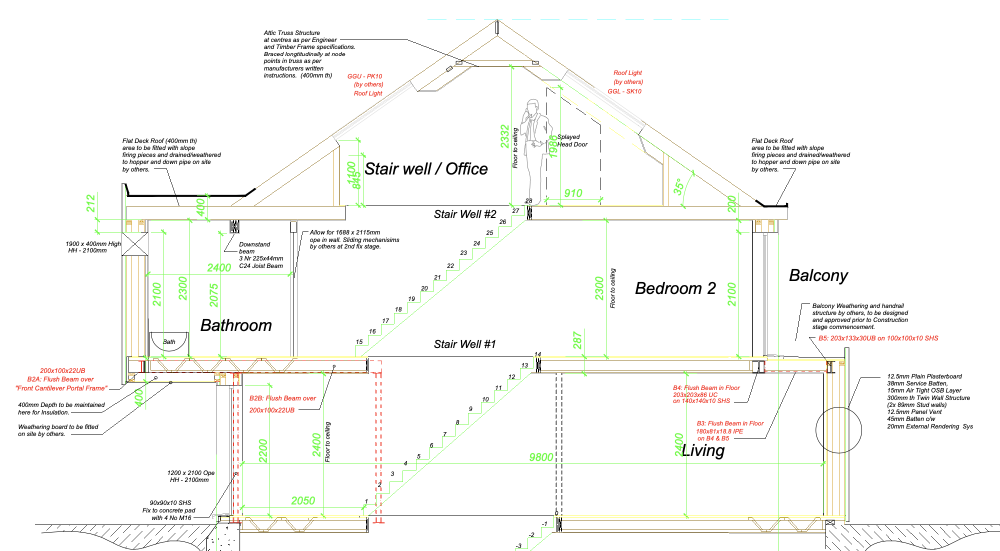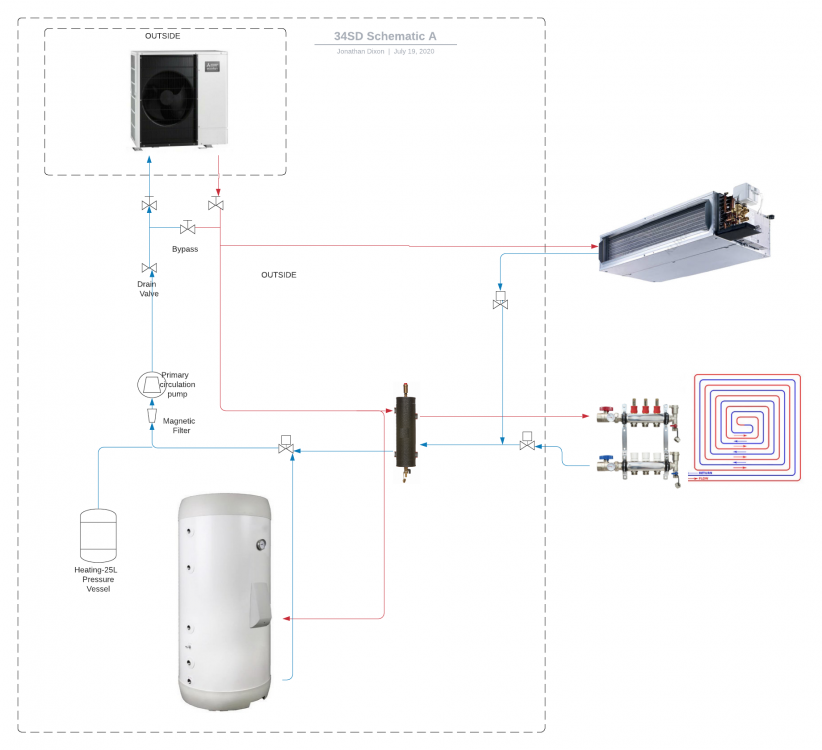Leaderboard
Popular Content
Showing content with the highest reputation on 07/19/20 in all areas
-
This is only a short update because we've been taking it easy on the house so the boss and I can get some (paid) work done. Will be the school holidays soon - so slave labour will be available! I have ordered some plain and simple white UPVC soffits and facia from a local company so time to start measuring up and cutting the splines level. More work for the Alien and some string. The plumb line is made from a Lotus Elise crank pulley bolt! Hopefully the soffits and facia will be installed around the middle of next week. We have some roofing membrane on the roof. About half way there... Just the difficult half to go! My daughter wanted to see the view from the ridge, and who am I to argue? Lets not mention how utterly terrifying this is for a parent! (Even if I was up there moments before!) I have made sure she's been thoroughly chastised over even the smallest transgression when at height and while she's nearly a teenager she will still listen to me over some things. And what a view it is! This is from one of the gable "hop ups" (Why the scaffolders call them this I don't know. You'd need to be awfully tall to hop on to it.) Our neighbours visitied. This is the view from their garden. The green membrane does blend in nicely, so I believe the pale green cladding colour is the right choice. There is still some discussion about the grey window frames.3 points
-
I have just fitted10 Fibo panels. The quality of the panels is very good but I did find it super awkward to fit as none of the walls are plumb or square in the renovation project I am doing. There was a lot of panel scribing involved into the corners. We also used the tile effect panels which gives you the added complication of having to line up the “grout” lines. I used Styxall for sticking the panel to the walls and a hybrid sealant for joining the t&g. Think I ended up with more on me than on the panels. Looks fab but I wouldn’t be in a hurry to do it myself again, think I would pay someone to do it the next time. Panels are only 600mm wide so can be quite expensive when you price it up. Make sure you store flat as they can distort ever so slightly in storage then they become a huge pain to interlock, I had one odd panel not in a pack and not stored flat and although it looked fine it wasn’t funny.2 points
-
There is a rule of thumb about the ratio of glazing (whether windows or rooflights) to floor area. A figure of 10 - 15% is typically quoted. Having too much light can be problematic for causing fading of materials and so on, as well as the problems you mention for heat gain and loss. I wonder what the percentage is for your proposed L-shaped kitchen. Furthermore, for a given area of glazing, a roof light is generally far more effective at letting in light than a window, particularly when mullions and frame are accounted for, which tend to be larger for windows than rooflights.2 points
-
I would be more concerned about it being too hot in the summer, unless it is shaded. Flat versus pitch is really down to the look you want. Have you priced up a roof lantern that big. And the weight of it. I bet that’s over 200kg, you won’t be picking it up on your shoulder and carrying it up a ladder. Architects like to draw things without much thought on how to build it.2 points
-
Hi. If it's triple glazed then it should be reasonably high performance so maybe not such an issue. You can get 'the numbers' off each proposal and compare them side-by-side to gauge the impact of either choice. You could also choose to offset the losses of a larger window by beefing up the insulation level in the rest of the roof structure. Adding 30mm of PIR over the face of the joists before plaster-boarding for eg would be one way. Conversely, consider the adventitious heat gains from solar gain with the larger window and weigh up the pro's and con's And welcome!2 points
-
So, progress has continued and after months of walking round looking at drawings I can actually see proper rooms which is all very exciting. My necessity of carrying lip gloss everywhere has been replaced with a tape measure which is now a handbag essential! I've become almost obsessive checking sizes of rooms, window openings and that potential bathroom purchases will fit. My tape measure had that much use it finally broke! One stand out moment was the steels for the 5.5 metre Internorm doors (modelled by the wife) and the corner window. This will be the kitchen dining room and look out up to the canal so will be one of my favourite places. The inside of the bungalow looks like a group of lads have had the worst house party ever and the chimney, naff red fireplace (see previous forum post), 70s bathroom and bedroom have all gone along with some of the windows, though neither of quite made it out of the house yet so it's just piles of rubble. In the absence of a chimney we have gained an impromptu skylight with view of the wasps nest. Internorm did their technical survey earlier this week and we just need to iron out the measurements of the 'triangle bits' above the huge sliders and hopefully will have our window order placed on Tuesday. The lead times mean potentially the windows will pretty much be the last things to go in which to be isn't a bad thing, less chance they will get damaged. Here is some pics. We are spending a rainy Saturday afternoon arguing about knobs.1 point
-
@puntloos With all the various posts in relation to layouts, regulations, processes, etc... what exactly is your architect doing or advising upon? The majority, if not all of these this would normally be dealt with by them. Are they literally just a draughts(wo)man and have been instructed/paid as such?1 point
-
To my surprise, we managed to lift and move all the sand from the green area to the pink area, in about 4 hours. It wasn't just sand but also some solid concrete, but while it took time to break it, it was also easier to pick those large pieces (compared to the other find sand). The old tiles that were buried under the sand are now exposed, I need to lift them and fill with the soil from the former flowerbed in the blue area. I lifted some of them and this time underneath the tiles there should be just soil, no more sand or concrete. I'll leave the path as it is and lay on top the new tiles. I have two options on the table now: SIP kit or "lightweight metal C stud" kit. With SIPs the floor panels could sit directly on top of ground screws or concrete. If I get the lightweight metal frame, I will need to build my own base (it is not provided). Any suggestion? Quadrabase is ultraexpensive and I would like to avoid concrete. I am not sure I understand: could you explain it once again? Any suggestion on how to get rid of the weed? I keep killing it with weedkiller but it comes back after heavy rain. Once killed (again), if I roll the turf over, will the weed continue to grow trough the grass? If so, how do I kill it without killing the grass as well?1 point
-
1 point
-
The previous owner secured pp for the garage here that is well forward of the principle elevation albeit off to one side. Though still a fair distance from the road, as the house itself is, they insisted the garage had a hip end or so I was told.1 point
-
Any alteration to a roof that is forward of the front elevation cannot normally be carried out under PD. Outbuildings themselves cannot be installed forward of the front elevation should you end up considering a replacement. A formal Planning application would in my opinion be required and should have no issues in being approved.1 point
-
I found a man with a set and have been cleaning it out all day ,but it was successful eventually + his set returned1 point
-
We had a similar challenge - first planning app rejected and one of the reasons was the ridge height exceeding the previous dwelling. Our planning solution was to have ground floor at 2400mm, first floor at 2300mm and make the best of the room in roof space, which was 2330mm. When we got the detailed drawings from MBC, we were still 100mm off as the floor decks were thicker than anticipated. We solved that by just going 100mm further down with the basement / foundation - the limits there were governed by getting the necessary foul drops from the downstairs loo to the street sewer - lots of calculations on the invert levels for each IC but we made it ok. Could have tried to get away with it but decided not worth the risk. Was worried that @2400mm the GF ceiling would feel too low but it's fine - as its all open plan and lots of floor to ceiling windows, it's never bothered us. Just to add, as we're effectively a 4 story house (basement, GF, FF, RIR), every door that opens onto the hall / stairway from a habitable room (i.e. excluding bathrooms) is FD30 rated with fire strip. We have a nice glazed 926mm door into the GF hallway and it got very expensive as the glass needs to be FD30 also. We did not need to use fire rated PB (pink) as standard 12.5mm with a skim is considered to give 30min protection. Basement also needed independent means of exit so there is a separate door there that opens to stairs up to ground level.1 point
-
I have, and you're very welcome (if you don’t mind driving to near cornwall and back )?. Borrow or hire a Jenny? (I have one of those for sale as well!1 point
-
Usually wind and watertight is the next big stage after foundations. We aimed for that when we were building and taking the first drawdown. We had our roof slated but I believe some even consider a roof membrane as being sufficient. But having the windows and a doors is definitely needed for that stage. Why not use the funds to get those installed and then request the second valuation. It might even be worth contacting the valuer to ask how that would impact their valuation, a quick five minute call might help.1 point
-
I gave it a go, but really didn't get far - every time I try and import an image it hangs (beach-ball of doom on my Mac) I played around with lucidchart.com yesterday and got quite far quite quickly. It's a bit annoying to connect the wires (pipes) to small components like valves, and the routing all goes a bit mental if you move things around too much, but for a free online app it's very usable. (Still very much WIP, but gives the idea)1 point
-
Just to clarify, by "here" I mean in the specific planning authority where the OP is going to be placing their planning application (we live in the same town), and which is widely regarded as one of the most expensive and least efficient to deal with. (Our own application (a simple renovatin/extension) was delayed 5 weeks because as the end they realized they'd incorrectly reissued the original plans to the local parish council when we made a minor amendment early on. I spoke to the parish council and they said they don't even look at minor amendment after approving the original plans, so I was at least able to gee up the district council a bit when I shared this intel with them...)1 point
-
Yes I used Multipanel in 1200 wide by 2400 tall sheets. They were about £100 each from Jewson to order, WAY cheaper than the same thing in any of the bathroom shops. If you need to cut any, as I did with a "room in roof" bathroom, I templated first with large sheets of cardboard, get that right then use that to mark the real panels for cutting.1 point
-
Have a look at what @ProDave did in "Main Bathroom Complete": http://www.willowburn.net/ Imo 600 wide panels are a bit daft and introduce an unnecessary joint. Wider panels the way to go with as few joints as possible.1 point
-
Just don’t indicate any rooflights or dormers to the roof planes along with not providing them with a second floor plan. As and when you come to order the attic trusses, make sure there are allowances for double/triple trusses for any future openings.1 point
-
One additional thought. You say it had been on the market for years before you bought it, and that the conservation officer thought it was listed with higher protection than perhaps is warranted. I therefore wonder whether they would consider delisting it? Faced with the choice between it eventually falling down, or a refurbishment that was sympathetic to the original building but requiring a less demanding treatment may be preferable to the local authority - and significantly less expensive for you.1 point
-
Welcome, it also depends if you are stealing light from the room(S) behind and need the light in the roof to make up fir it. It also depends which way it faces. We have a large south facing conservatory which everyone said would overheat but we love it, enough windows to allow plenty of air during hot weather.1 point
-
1 point
-
Then I have to be honest and say I'd be inclined to walk away, sell it for whatever you can get for it and swallow the loss. However, it sounds as though you're determined to find a way through this so my suggestion would be to turn the stable into your temporary home, even if that means spending a few grand that you feel would be better spent on the main house. It doesn't need to be fancy, just safe, dry and warm enough that your health doesn't suffer again this winter, with a loo, shower and basic cooking facilities. You'll need somewhere to stay while the dry rot work is done anyway, and even once that is done there'll be a lot of work (and cost) to get the main house livable.1 point
-
So true! Like everyone else, I would suspect that summer comfort is the main worry these days. The extension will need to be pretty well insulated to pass building control so should stay reasonably warm. Also, plenty of solar gain from the lantern window will help even under winter sun. (I expect it will look pretty good too.) I suggest doing a bit of maths to look at heat losses through the walls. There's a handy guide and a spreadsheet on Buildhub for helping with this. When all said and done most things can be made to work, but some of them might end up cheaper than others. And of course, welcome!1 point
-
Might be higher - Kitchen units are of a standard height, more so than toilets so could be when the bricks would be at the height of a pan of sizzling bacon? I've never heard of it either, but I've only half built one house.1 point
-
1 point
-
I appreciate that and of course the LPA will need to know if you convert the loft later. But my point is the OP thinks PP will be refused if they think there is a chance the loft could be converted later. I don't think that would be the case.1 point
-
Gosh, you poor thing, that must be so hard for you. I know what it is to have a love affair with an old house. Random musings: Have you thought about crowd funding? A couple raised cash on Grand Designs by this method. You might appeal to people who love old buildings. What will you get for your £100k from the dry rot co? Will they replace all the timber and make the house good as new with a guarantee? Could you find a hardy lodger who might be willing give you a few hours work a week in return for a roof over their head? Good luck xx1 point
-
Design for what you want. Planning won't be looking for "oh my god they could convert the loft" Height of roof is dictated by size and pitch. Just choose those so the loft is tall enough for rooms, and choose other ceiling heights for what you want. Build the roof structure with attic trusses properly designed for the later loft conversion. Planning don't need to know you are doing that, that is a building regs issue. All planning need is the size pitch and type of tile not how the roof is physically constructed. Better still build as a warm roof from a ridge beam and you have so much more flexibility. Build in structural openings for roof windows then frame over them and tile to make it easy to open up later and fit roof windows.1 point
-
You have presumably considered sprinklers, which relax various fire requirements?1 point
-
Compact yes, but remember that compact can = PITA to get furniture etc. up and down it - been there ? I was reading about protected staircases last week and from how I understood it you need to have something like a stair well with fireproof doors leading onto/off it from the lower floors. Makes sense really, imagine what would happen when somebody sets the (downstairs) kitchen on fire and you're tucked up in bed upstairs.1 point
-
My small 2kw Daikin unit had 10m of precharge gas. Perhaps look though the specs to see what suits. I found Saturn sales where helpful when sourcing a unit ( no affiliation) Longer pipe runs require extra gas so more tricky to DIY, but easy for an engineer, just costs a bit more1 point
-
The units come with enough gas in them for a certain run length, i seem to recall 6m but that may be the length of the pipe that comes as standard, and if you want to put longer pipework on (you can buy extensions) you have to get an F Gas engineer to come and top it up with more refridgerant.1 point
-
1 point
-
Will that brick down in the bend lift out? If so get your hand down and clear as much rubble as you can and then try some water down it. Is the extension solid floor or suspended? Are there any manholes in the vicinity? I wonder if the extension has been built over the manhole that pipe used to connect to? You can see which direction it is heading in, so go looking in that direction for a manhole. Perhaps go and find all the manholes you can and do a sketch of where they are around the house and in relation to this room?1 point
This leaderboard is set to London/GMT+01:00



















